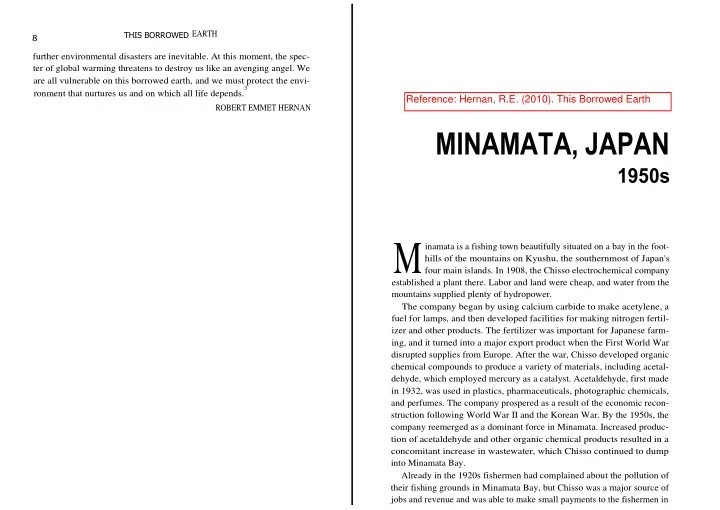

THIS BORROWED EARTH 8 further environmental disasters are inevitable. At this moment, the spec- ter of global warming threatens to destroy us like an avenging angel. We are all vulnerable on this borrowed earth, and we must protect the envi- 3 ronment that nurtures us and on which all life depends. Reference: Hernan, R.E. (2010). This Borrowed Earth ROBERT EMMET HERNAN MINAMATA, JAPAN 1950s M inamata is a fishing town beautifully situated on a bay in the foot- hills of the mountains on Kyushu, the southernmost of Japan's four main islands. In 1908, the Chisso electrochemical company established a plant there. Labor and land were cheap, and water from the mountains supplied plenty of hydropower. The company began by using calcium carbide to make acetylene, a fuel for lamps, and then developed facilities for making nitrogen fertil- izer and other products. The fertilizer was important for Japanese farm- ing, and it turned into a major export product when the First World War disrupted supplies from Europe. After the war, Chisso developed organic chemical compounds to produce a variety of materials, including acetal- dehyde, which employed mercury as a catalyst. Acetaldehyde, first made in 1932, was used in plastics, pharmaceuticals, photographic chemicals, and perfumes. The company prospered as a result of the economic recon- struction following World War II and the Korean War. By the 1950s, the company reemerged as a dominant force in Minamata. Increased produc- tion of acetaldehyde and other organic chemical products resulted in a concomitant increase in wastewater, which Chisso continued to dump into Minamata Bay. Already in the 1920s fishermen had complained about the pollution of their fishing grounds in Minamata Bay, but Chisso was a major source of jobs and revenue and was able to make small payments to the fishermen in
THIS BORROWED EARTH 10 MINAMATA, JAPAN 11 practices began to catch up with the company as the pollution's impact began to be felt by inhabitants of Minamata and neighboring villages. Fishing was always a critical resource in Minamata. What the fisher- men did not sell, they and their families and neighbors ate. In the early 1950s, mullet, lobster, and shad began to disappear from the once-fertile fishing grounds. Dead fish were found floating on the sea; birds dropped dead from the sky. The local fishermen had to borrow money to eat and to buy nylon nets in order to capture what few fish were left. Nets were often lifted out of the sea bearing only a heavy sludge from Chisso's wastewater. The cats in the village started to dance crazily, bash themselves against walls, jump into the sea, and drown. In 1954, Dr. Hajime Hosokawa, director of the hospital at the Chisso plant, began to see patients with impaired nervous systems. Mostly fisher- men and their families, they had difficulty walking and talking and suf- fered wild mood swings. Their bodies were racked with convulsions. Most disturbing, newborns were exhibiting symptoms, which indicated the pres- ence of a congenital form of the disease. Local health officials conducted a survey of physicians in the area and found that scores of patients had presented similar symptoms and that many of them had died. Especially affected were the fishing communities south of Minamata, where several members of the same family were often afflicted. Eiko Sugimoto was born in Mock', a small fishing community just south of Minamata. Her father was the boss of the local net fishery, and as the only child, though a girl, she was expected to carry on the business. One day in 1958, she returned home from a fishing trip and found her mother confused and unable to light her cigarette; the floor was covered with matches. Sugimoto's father took her mother to the hospital. Since this strange illness appeared to affect members of the same family, neighbors feared the disease might be contagious. When Sugimoto walked down to the shore to care for their boat, she was stoned by her friends and neigh- The gnarled hands give testimony to the effects of the mercury poisoning. bors. Covered with cuts and bruises, she tried to find comfort and safety Credit: Shisei Kuwabara, courtesy of the artist in a neighboring house. Instead, her neighbors threw excrement on her. Shopkeepers refused to touch the diseased; they made them pass their in the area. But no one knew what was in the wastewater, and Chisso was money in special baskets or leave it on the floor so it could be picked up not providing any information. Researchers struggled with studies of a with chopsticks. When Sugimoto and her father also felt sick, they hid host of pollutants found in the bay and were not able to isolate any par- it. Treated like lepers in their own communities, the victims felt deeply ticular toxic material that would cause such a disease. ashamed. Recriminations destroyed once-close fishing communities. In late 1958 a British neurologist who had visited Minamata suggested As the disease spread through the mid-1950s, suspicions fell on Chisso's in The Lancet that the disease's symptoms were similar to those Produced
Recommend
More recommend